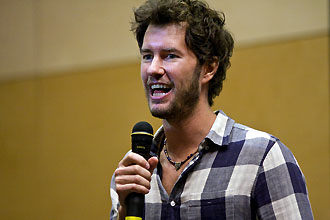Making Shoes and Making a Difference
If the huge crowd in the Kendall Cram Lecture Hall in the Lavin-Bernick Center on Tuesday night is any indication, Blake Mycoskie is some kind of star. Not a rock star, or a movie star, but a new kind of star whose arena is social entrepreneurship the vocation of doing well by doing good.

"We started not as a business that wanted to help people, but wanting to help people and realized we needed a business to fund it," said TOMS Shoes founder Blake Mycoskie to a packed house in the Kendall Cram Lecture Hall on Tuesday (March 9). (Photo by Ryan Rivet)
Mycoskie is founder and "chief shoe-giver" of TOMS Shoes, whose business model states that for every pair of shoes purchased, one pair will be donated to children in developing nations who have none.
As a speaker in the NewDay Social Entrepreneurship Distinguished Speakers Series, Mycoskie was on campus to tell the story of how he started his company and to inspire the audience to get involved with something similar.
During a trip to Argentina, Mycoskie wound up working on a shoe drive for poor children so they could attend school. Feeling good about what he had done, Mycoskie wondered what would happen when the childrens' feet outgrew the shoes.
"I was so caught up in how good it felt to do the giving that I didn't think about how difficult it would be to sustain this charitable model," Mycoskie said. "I went to bed that night thinking 'there's got to be a better way.'"
That turned out to be the "one-for-one" model that has turned TOMS Shoes both into a fashion statement and a model for social entrepreneurial ventures. TOMS has distributed more than 440,000 pairs of shoes and shows no signs of slowing down.
Mycoskie told the audience the fact that TOMS has giving at the forefront of the model has been the secret to his success. The concept that garnered national publicity allowed the company to move out of Mycoskie's kitchen and to place its product in some of the largest retailers in the world.
"We started not as a business that wanted to help people, but wanting to help people and realized we needed a business to fund it, "Mycoskie said. "People saw the authenticity of that and wanted to help."
